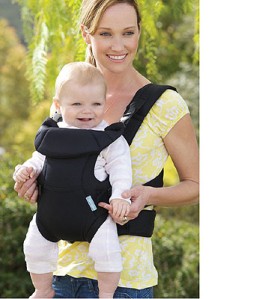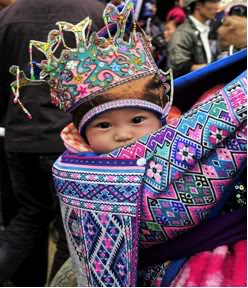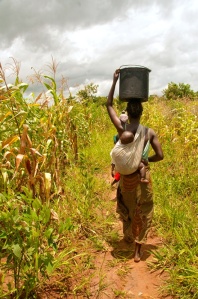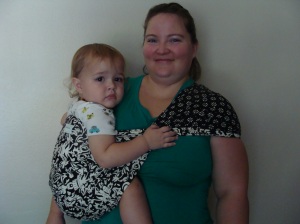Glossary of Babywearing Terms
Adapted from Babywearing International website.
Babywearing (BW): Carrying or holding a baby or young child by means of wearing a baby carrier. (Also, babywear, babywearer.) Sometimes spelled as two separate words, i.e., baby wearing.
Baby carrier: An item made exclusively or primarily of fabric, worn on a caregiver’s body and used to carry or hold a baby (or child) with little or no support from the caregiver’s arms. [In common usage, may also mean specifically a structured baby carrier, or any baby carrier with straps (as opposed to a wrap or sling made of a cloth of more or less even width); however, BWI considers the term to mean any type or kind of carrier.]
Carrier Types and Features
Adjustable pouch: A pouch which uses snaps, zippers, ties or other similar means to adjust the length of the loop of fabric, allowing the overall size of the pouch to be adjusted to fit different wearers, or accommodate weight gain/loss, bulky winter clothing, etc.
Amauti or amautik: A traditional Inuit woman’s garment that is essentially a warm coat with a pouch for carrying a baby built into the upper back. It has a large hood that covers both baby’s and wearer’s heads for warmth.
Asian-style baby carrier (ABC): A baby carrier of a style based on those traditional in Asian cultures, consisting of a roughly square or rectangular body panel with straps attached at some or all of the corners. Includes mei tai (the best known style in the modern West), podaegi, onbuhimo, and others. Sometimes known as an “Asian back carrier” although most types may be used for front carries also.
Bei bei: An Asian-style baby carrier consisting of a large rectangular body panel or “blanket” attached to a long top strap that is worn over the shoulders or around the torso and then wrapped behind to secure the baby in the blanket. Essentially the same as a podaegi, but originating from China rather than Korea.
Body: The part of a baby carrier in which the carried child’s trunk is supported. Used most often in reference to ABCs and buckle carriers, but also refers to the central portion of a ring sling or pouch.
Buckle carrier: An Asian-style baby carrier or one based on the same general construction and use, but which uses buckles to fasten the straps rather than being secured by tying or tucking. Includes soft structured carriers, buckle tais and half buckles, and frontpacks; sometimes used interchangeably with “soft structured carrier.”
Buckle tai: A buckle carrier that is constructed and functions much like a mei tai, but uses buckles to fasten the straps. Typically refers to an unstructured carrier which does not have firm padding, especially in the waist/hip belt, but sometimes used interchangeably with “soft structured carrier.”
Chunei: A buckle carrier that is based on the Korean podaegi, consisting of a body panel that wraps around the wearer’s torso and is secured with hook-and-loop fastener and buckled straps.
Closed tail ring sling: A ring sling in which the free end (the one not sewn to the rings) is folded or pleated into a narrow strap and sewn closed.
Contoured: A mei tai body with curved sides and top, designed to fit the contours of the baby’s body.
Curved top: A mei tai body with a curved top which can be folded down or flipped up and used as a headrest. Distinguished from a framed body, which most often does not have a headrest.
Fitted pouch: A pouch which is sewn to a specific size, so as to be fitted to the wearer.
Frame pack or framed pack: A baby carrier that incorporates a rigid frame, typically of metal. Similar to a hiking/camping type backpack and usually made exclusively for back carries.
Framed: With respect to mei tais, refers to a body that consists of a decorative fabric panel bordered by a “frame” of sturdier fabric, typically the same as that used for the straps.
Frontpack: A variant of soft structured carrier that is used exclusively for front carries, and typically lacks any waist or hip belt.
German-style woven wrap: A woven wrap made using a particular style of fabric and weave that originated with German brands and is specifically designed to function well as a baby carrier.
Half buckle: A hybrid of mei tai and soft structured carrier or buckle tai in which one set of straps (more often, but not always, the waist/hip belt) are fastened with buckles, and the other set (more often, but not always, the shoulder straps) are long straps secured by tying a knot.
Headrest or head support: A flap of fabric at the top of a carrier body, sometimes reinforced with padding, extra layers or special stitching, used to help support the baby’s head.
Hip carrier: A variant of Asian-style or buckle carrier designed primarily or exclusively for hip carries, consisting of a body panel or seat for the baby, a waist or hip belt and a single shoulder strap worn across the wearer’s upper body. Usually fastens with buckles, especially at the wearer’s waist, but may use ring sling style rings.
Hood: A hood or flap of fabric attached to the top of the body of a carrier, usually an ABC, and used to cover and/or support the baby’s head. Typically larger than a headrest, and often the upper edge attaches to the carrier’s shoulder straps with narrow straps or cords, which may be fastened by clips, snaps or similar.
Hmong carrier: An Asian-style baby carrier traditional among the Hmong people of Southeast Asia, consisting of a rectangular body panel and a long top strap, connected by a smaller rectangular panel of fabric. Functionally very similar to a narrow-blanket podeagi. Typically heavily embroidered and decorated, Hmongs are often collected for their artistic value as well as for their function as baby carriers.
Hybrid: Any carrier that incorporates defining features of any two or more different carrier types. For example, a ring sling with a curved pouch seam in the body is known as a “hybrid sling” or “hybrid pouch.”
Kanga or khanga: A multipurpose simple piece of cloth, traditional in East Africa, consisting of one or, most often, a pair of approximately 1 meter by 1.5 meter rectangles made of woven cotton and decorated with bold designs which frequently include a Swahili motto or slogan. Frequently used for torso carries.
Knot sling: See “shawl carrier”
Mei tai (MT): An Asian-style baby carrier with four straps, one more or less at each corner of a generally squarish or rectangular body panel (approximately 12-20” wide and 15-23” tall), worn by seating the baby in the body panel and tying the straps around the wearer. Traditional in China; modern versions are the most popular type of ABC in Western countries.
Onbuhimo: An Asian-style baby carrier with two straps, one at each upper corner of a rectangular body panel, and rings or loops at each lower corner of the body panel, worn by seating the baby in the body panel and tying the straps around the wearer. The straps are threaded through the rings or loops near the wearer’s waist. Similar to a mei tai, but without separate long waist straps.
Open tail ring sling: A ring sling in which the full width of the free end (the one not sewn to the rings) remains a flat piece of fabric, rather than being sewn into a narrower strap.
Padded ring sling: A ring sling with padding sewn inside the rails and/or shoulder area.
Podaegi (or podegi): An Asian-style baby carrier consisting of a large rectangular blanket attached to one long top strap that extends from each upper corner, worn by wrapping the blanket around the baby and wearer and securing by tying the straps. Traditional in Korea and other parts of Southeast Asia; often used for torso carries. (See also, “Bei bei.”) Available in “wide blanket” and “narrow blanket” variations; the body of the narrow blanket type is approximately the same width as the body of a mei tai or onbuhimo, but longer.
Pouch or pouch sling: A more-or-less rectangular piece of cloth sewn into a closed loop, used as a baby carrier by wearing the loop around the body, generally from shoulder to hip, and usually folded in half lengthwise so as to form a pocket or pouch for carrying the baby. Typically has a curved seam which forms a more secure seat for the baby. Sometimes known as a “tube sling”.
Rail: The long edge of each side of a ring sling, pouch, or wrap. In a ring sling or pouch, may be padded or unpadded; is sometimes embellished with embroidery or trimming. The “inner rail” is the rail next to the wearer’s body; the “outer rail” is the rail supporting the baby on the side opposite the wearer.
Rebozo: A fringed shawl that is a traditional female garment in Latin American countries, used for a variety of purposes including labor/childbirth support, goods carrier, and baby carrier. As a baby carrier, it is essentially a short (2 to 3 meters) wrap, usually worn shoulder-to-hip similar to a ring sling or pouch, but fastened by knotting or twisting the ends together as with a longer wrap.
Ring sling (RS): A more-or-less rectangular piece of cloth with two rings sewn to one end, used as a baby carrier by threading the “free” end through the rings and wearing the sling looped around the wearer, generally from shoulder to hip.
Selendang: A traditional Indonesian shawl, consisting of a rectangular piece of cotton batik fabric, often used as a baby carrier as well as for other purposes. As a baby carrier, it is essentially a short, wide wrap (less than 3 meters long and approx. 1 meter wide), usually worn shoulder-to-hip similar to a ring sling or pouch, but secured by twisting and tucking the ends.
Shawl carrier or knot sling: An item of clothing consisting of a square or rectangular simple piece of cloth (without straps), traditionally used in many cultures for a variety of purposes including as a baby carrier. Different sizes, fabric types and designs, as well as different methods of wearing and tying, are typical of different regions and cultures. Includes rebozo (Mexico), manta (Peru), selendang (Indonesia), pareo (Tahiti), sarong (Pacific Islands), kanga (East Africa), kitenge (Eastern and Southern Africa) and others.
Shorty or short wrap: A wrap between 3 and 4 meters long. Functionally very similar to a long or “regular” wrap but more convenient for wrap methods requiring less cloth, including one-shoulder hip carries, and not usable for other wrap methods that require more cloth.
Shoulder style: The method by which the width of the fabric of a ring sling is gathered or pleated to fit through the rings. The shoulder style of the sling affects the way the sling fits to the wearer’s shoulder.
Simple piece of cloth (SPOC): Synonomous with wrap, but often implies a homemade version or something multi-purpose rather than a cloth specifically designed as a baby carrier.
Sling: (1) Ring sling; (2) Any baby carrier consisting of one strip of cloth of approximately even width (rather than one with straps); i.e., a wrap, ring sling or pouch; (3) Any one-shoulder baby carrier; i.e., ring sling, rebozo or pouch; (4) Any unstructured baby carrier. Not a preferred term due to the multiple common uses, which render it ambiguous.
Slingified wrap and to slingify: A “slingified” wrap is one that has been sewn into a ring sling by adding rings, gathers or pleats at the shoulder, and usually shortening the length. To “slingify” a wrap or any other piece of fabric means to turn it into a ring sling. Brand or vendor names are sometimes turned into verbs to describe slingification by that vendor or using that brand’s shoulder style.
Soft structured carrier (SSC): A structured carrier which incorporates padding, stitching and/or stiff fabrics, rather than a rigid frame, to provide the structure. Most often refers to a modernized version of a mei tai that has a firmly padded hip/waist belt in place of the waist straps, and well-padded shoulder straps with buckle adjuster/fasteners. Sometimes called a “technical carrier.”
Stretchy wrap: A wrap made of knit or otherwise stretchy fabric.
Structured carrier: A carrier which retains some of its shape or structure even when not being worn, due to incorporating padding or a rigid frame. Typically also fastens with buckles, rather than by tying or tucking.
Tail: Any fabric that hangs loosely down from a knot or fastener. In a ring sling, the end of the sling that is threaded through and flows down from the rings; in a wrap, the loose ends of the wrap below the knot; in a mei tai, the loose ends of the straps. In a ring sling and occasionally on mei tai straps, sometimes decorated with a panel of different fabric (“tail accent”) or other trim. A “tail pocket” is a storage pocket located on the tail.
Technical carrier: See “Soft structured carrier.”
Traditional carrier: (1) Any unstructured carrier that is used in non-industrialized cultures; (2) Any modern soft carrier based on a traditional style; distinguished from a structured carrier by the lack of firm padding, framing, buckles or other elements that give the carrier shape when not being worn.
Tube sling: See “Pouch.”
Unpadded ring sling: A ring sling with no padding sewn in.
Woven wrap: A wrap made of woven fabric; used to distinguish from stretchy wraps.
Wrap: A long, more-or-less rectangular piece of cloth used as a baby carrier by means of wrapping the entire cloth around the caregiver’s and baby’s body and tying or otherwise securing the ends, without the use of separate ties or fasteners such as buckles or rings. Sometimes called a “wraparound carrier.” Most often, but not always, refers to a long wrap, 4 meters or more.
Carrier Usage Terms
Back carry: Any carry in which the baby is worn on the back of the wearer’s body.
Braid: A method of twisting/tying a wrap for compact storage, which can also help “break in” or soften the fabric. Not used for wearing.
Carry: (1) The position of the baby on the wearer’s body; e.g., front, hip or back; (2) The position of the baby in relationship to the carrier or the wearer; e.g., cradle or kangaroo (which are different types of front carries). (3) The method of wrapping and/or tying the carrier around the wearer; e.g., cross carry, wrap cross carry.
Cradle carry: A carry in which the baby is cradled across the wearer’s body in a reclining or semireclining position. In a one-shoulder carrier, the baby’s head is pointed toward the weight-bearing shoulder.
Cross: In describing a method of using a wrap carrier, such as “wrap cross carry” or “hip cross carry”, to “cross” means to bring both ends of the carrier over the wearer’s shoulders in such a way that they form an X (cross) on the wearer’s back and/or chest. Also used to refer to ABC straps forming an X on the wearer’s back or chest.
Froggy position or froggied legs: A position of the baby’s legs, knees bent upward with feet near the hips like a squatting frog. Generally used for upright carries with a newborn whose legs are too short to straddle the wearer as an older child would do. This is a natural, healthy position for a young infant.
Front carry: Any carry in which the baby is worn on the front of the wearer’s body.
Front facing out (FFO): Any front carry in which the baby faces outward, away from the wearer’s chest.
High back carry: A back carry in which the lower part of the baby’s body is positioned above the level of the wearer’s waist, often requiring that the fabric of the carrier be wrapped around the wearer’s chest or ribcage rather than waist or hips.
Hip carry: Any carry in which the baby is worn at or on the wearer’s hip. Sometimes called a side carry.
Hold: Synonomous with “carry,” but especially the second definition: the position of the baby in relationship to the carrier or the wearer, e.g., snuggle hold.
Kangaroo: An upright front carry position in which the baby faces outward, away from the wearer’s chest, with legs curled and tucked inside the carrier.
Pocket: In describing a method of using a wrap carrier, a “pocket” is formed when the ends of the carrier are tucked inside the horizontally wrapped portion of the carrier. A “pocket wrap cross carry” is the most common method of using a stretchy wrap. (May also refer to a storage pocket sewn into or on any carrier, most often the tail of a ring sling.)
Reverse cradle carry: A variant of the cradle carry in which the baby’s head is pointed away from the weight-bearing shoulder. Also known as a “nursing carry” although it is not the only position in which a baby may be nursed in a carrier.
Rucksack or ruck: Refers to fastening a baby carrier in a manner similar to a backpack or rucksack, with the fabric or straps coming over the wearer’s shoulders, straight down in the front (rather than crossing on the chest), and then winding to the back. Used with respect to wraps, mei tais and buckle carriers.
Semireclined: A variant of the cradle carry in which the baby is positioned “sideways” across the wearer’s body but in a slightly more upright seated position.
Snuggle hold: See “Tummy-to-tummy.”
Tibetan tie or Tibetan finish: A method of tying either a wrap or an ABC, in a back carry, in which the fabric is wound over the shoulders in a rucksack style, crossed behind the baby and then each end is tucked under the opposite shoulder strap (forming an X on the wearer’s chest) and brought back to the center of the sternum to tie.
Torso carry: A back carry in which the carrier is wrapped around the wearer’s torso and no weight is borne on the wearer’s shoulders. Typical of certain traditional carriers including the podaegi and kanga.
Tummy-to-tummy (T2T): An upright front carry in which the baby faces the wearer; could more accurately be termed a chest-to-chest carry. Also known as a snuggle hold.
Twist: When describing a method of using an Asian-style carrier, refers to twisting the straps around each other, usually behind the baby’s back so as to provide additional security and support for the baby’s weight, but sometimes as an alternative to crossing the straps on the wearer’s chest (in a back carry). Sometimes called a “Vietnamese granny twist” or “traditional twist.” When used in reference to a wrap, may mean a method of tying a rucksack carry that is essentially the same thing as for an ABC (often called a “Lexi twist” after a woman who popularized the method), or may mean to twist a section of the entire carrier around itself so as to form it into a thick, narrow, rope-like shape.
Upright carry or upright hold: Any carry or hold in which the baby is positioned with his or her torso vertical.
Wrap: In describing a method of using a wrap carrier, such as “wrap cross carry”, to “wrap” means to wind the carrier horizontally around the wearer’s torso.

























